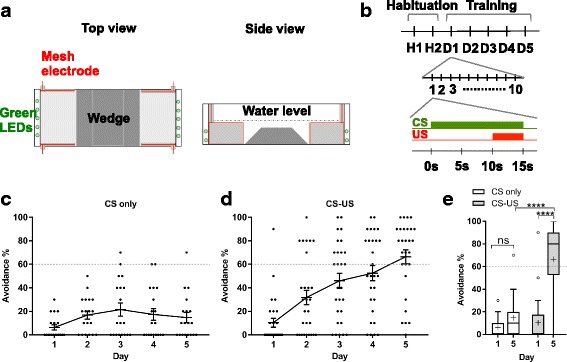Fig. 2.

Two-way active avoidance fear conditioning. a Shuttle box used for active avoidance conditioning. Top view (left) and side view (right). b Scheme for active avoidance conditioning. After habituation for 2 days, fish underwent 10 trials (with 25 ± 5 s intervals) per day over 5 consecutive days. In each trial, conditioned stimulus (CS; green LED) was presented followed by an unconditioned stimulus (US; electric shock) 10 s after CS, for 5 s; after this, both CS and US were turned off. If fish escaped during CS, then US was not given. c, d Performance of active avoidance response (%) of wild type fish treated only by CS (CS only: n = 19) (c) and by CS and US (CS-US: n = 28) (d). e Comparison of performance of active avoidance response of fish treated with CS only and with CS-US in Tukey box plot. Outliers are shown in open circles. Mean is marked by ‘+’. Two-way ANOVA, fish groups (CS-US wild type, CS-only wild type, and all double transgenic fish including fish described in Fig. 3 and Additional file 2: Figure S1) × training days (day 1, day 5), was performed (F = 7.236, P < 0.0001). Dunnett’s multiple comparison post-hoc tests were performed between CS-US and CS-only wild type fish on sessions on day 1 and day 5 (see also Fig. 3 and Additional file 2: Figure S1). The Student’s t test was performed on CS-US wild type fish between day 1 and day 5. ****P < 0.0001; ns, not significant
